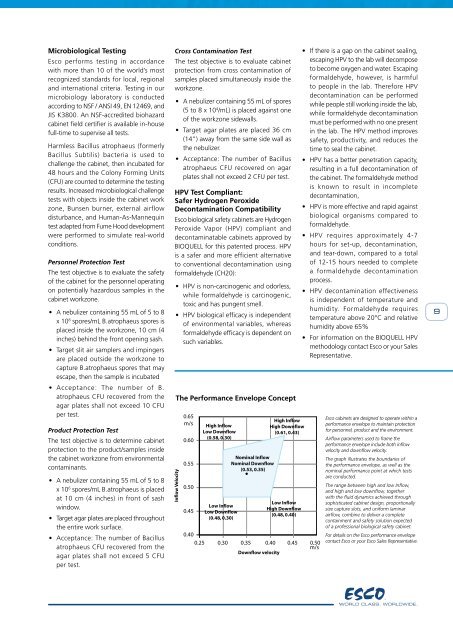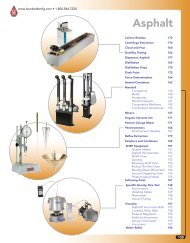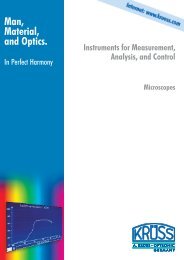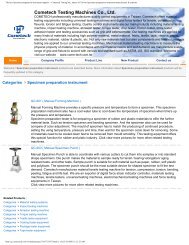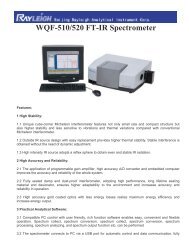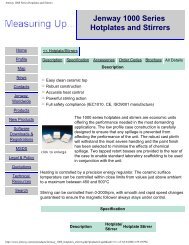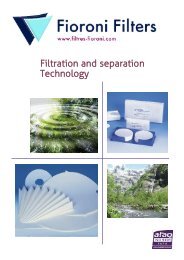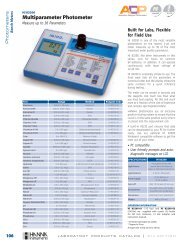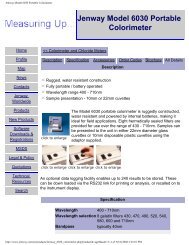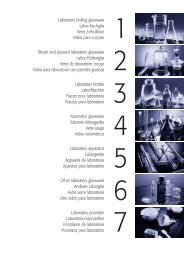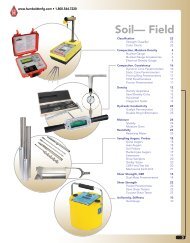Esco Labculture® Plus Class II Type A2 Biosafety Cabinet - Comlibris
Esco Labculture® Plus Class II Type A2 Biosafety Cabinet - Comlibris
Esco Labculture® Plus Class II Type A2 Biosafety Cabinet - Comlibris
You also want an ePaper? Increase the reach of your titles
YUMPU automatically turns print PDFs into web optimized ePapers that Google loves.
Microbiological Testing<br />
<strong>Esco</strong> performs testing in accordance<br />
with more than 10 of the world’s most<br />
recognized standards for local, regional<br />
and international criteria. Testing in our<br />
microbiology laboratory is conducted<br />
according to NSF / ANSI 49, EN 12469, and<br />
JIS K3800. An NSF-accredited biohazard<br />
cabinet field certifier is available in-house<br />
full-time to supervise all tests.<br />
Harmless Bacillus atrophaeus (formerly<br />
Bacillus Subtilis) bacteria is used to<br />
challenge the cabinet, then incubated for<br />
48 hours and the Colony Forming Units<br />
(CFU) are counted to determine the testing<br />
results. Increased microbiological challenge<br />
tests with objects inside the cabinet work<br />
zone, Bunsen burner, external airflow<br />
disturbance, and Human-As-Mannequin<br />
test adapted from Fume Hood development<br />
were performed to simulate real-world<br />
conditions.<br />
Personnel Protection Test<br />
The test objective is to evaluate the safety<br />
of the cabinet for the personnel operating<br />
on potentially hazardous samples in the<br />
cabinet workzone.<br />
• A nebulizer containing 55 mL of 5 to 8<br />
x 10 8 spores/mL B.atrophaeus spores is<br />
placed inside the workzone, 10 cm (4<br />
inches) behind the front opening sash.<br />
• Target slit air samplers and impingers<br />
are placed outside the workzone to<br />
capture B.atrophaeus spores that may<br />
escape, then the sample is incubated<br />
• Acceptance: The number of B.<br />
atrophaeus CFU recovered from the<br />
agar plates shall not exceed 10 CFU<br />
per test.<br />
Product Protection Test<br />
The test objective is to determine cabinet<br />
protection to the product/samples inside<br />
the cabinet workzone from environmental<br />
contaminants.<br />
• A nebulizer containing 55 mL of 5 to 8<br />
x 10 6 spores/mL B.atrophaeus is placed<br />
at 10 cm (4 inches) in front of sash<br />
window.<br />
• Target agar plates are placed throughout<br />
the entire work surface.<br />
• Acceptance: The number of Bacillus<br />
atrophaeus CFU recovered from the<br />
agar plates shall not exceed 5 CFU<br />
per test.<br />
Cross Contamination Test<br />
The test objective is to evaluate cabinet<br />
protection from cross contamination of<br />
samples placed simultaneously inside the<br />
workzone.<br />
• A nebulizer containing 55 mL of spores<br />
(5 to 8 x 10 4 /mL) is placed against one<br />
of the workzone sidewalls.<br />
• Target agar plates are placed 36 cm<br />
(14”) away from the same side wall as<br />
the nebulizer.<br />
• Acceptance: The number of Bacillus<br />
atrophaeus CFU recovered on agar<br />
plates shall not exceed 2 CFU per test.<br />
HPV Test Compliant:<br />
Safer Hydrogen Peroxide<br />
Decontamination Compatibility<br />
<strong>Esco</strong> biological safety cabinets are Hydrogen<br />
Peroxide Vapor (HPV) compliant and<br />
decontaminatable cabinets approved by<br />
BIOQUELL for this patented process. HPV<br />
is a safer and more efficient alternative<br />
to conventional decontamination using<br />
formaldehyde (CH20):<br />
• HPV is non-carcinogenic and odorless,<br />
while formaldehyde is carcinogenic,<br />
toxic and has pungent smell.<br />
• HPV biological efficacy is independent<br />
of environmental variables, whereas<br />
formaldehyde efficacy is dependent on<br />
such variables.<br />
Inflow Velocity<br />
The Performance Envelope Concept<br />
0.65<br />
m/s<br />
0.60<br />
0.55<br />
0.50<br />
0.45<br />
High Inflow<br />
Low Downflow<br />
(0.58, 0.30)<br />
Low Inflow<br />
Low Downflow<br />
(0.48, 0.30)<br />
Nominal Inflow<br />
Nominal Downflow<br />
(0.53, 0.35)<br />
0.40<br />
0.25 0.30 0.35 0.40<br />
Downflow velocity<br />
High Inflow<br />
High Downflow<br />
(0.61, 0.43)<br />
Low Inflow<br />
High Downflow<br />
(0.48, 0.40)<br />
0.45<br />
• If there is a gap on the cabinet sealing,<br />
escaping HPV to the lab will decompose<br />
to become oxygen and water. Escaping<br />
formaldehyde, however, is harmful<br />
to people in the lab. Therefore HPV<br />
decontamination can be performed<br />
while people still working inside the lab,<br />
while formaldehyde decontamination<br />
must be performed with no one present<br />
in the lab. The HPV method improves<br />
safety, productivity, and reduces the<br />
time to seal the cabinet.<br />
• HPV has a better penetration capacity,<br />
resulting in a full decontamination of<br />
the cabinet. The formaldehyde method<br />
is known to result in incomplete<br />
decontamination,<br />
• HPV is more effective and rapid against<br />
biological organisms compared to<br />
formaldehyde.<br />
• HPV requires approximately 4-7<br />
hours for set-up, decontamination,<br />
and tear-down, compared to a total<br />
of 12-15 hours needed to complete<br />
a formaldehyde decontamination<br />
process.<br />
• HPV decontamination effectiveness<br />
is independent of temperature and<br />
humidity. Formaldehyde requires<br />
temperature above 20°C and relative<br />
humidity above 65%<br />
• For information on the BIOQUELL HPV<br />
methodology contact <strong>Esco</strong> or your Sales<br />
Representative.<br />
0.50<br />
m/s<br />
<strong>Esco</strong> cabinets are designed to operate within a<br />
performance envelope to maintain protection<br />
for personnel, product and the environment.<br />
Airflow parameters used to frame the<br />
performance envelope include both inflow<br />
velocity and downflow velocity.<br />
The graph illustrates the boundaries of<br />
the performance envelope, as well as the<br />
nominal performance point at which tests<br />
are conducted.<br />
The range between high and low Inflow,<br />
and high and low downflow, together<br />
with the fluid dynamics achieved through<br />
sophisticated cabinet design, proportionally<br />
size capture slots, and uniform laminar<br />
airflow, combine to deliver a complete<br />
containment and safety solution expected<br />
of a professional biological safety cabinet.<br />
For details on the <strong>Esco</strong> performance envelope<br />
contact <strong>Esco</strong> or your <strong>Esco</strong> Sales Representative.


